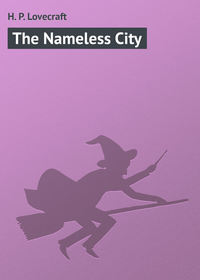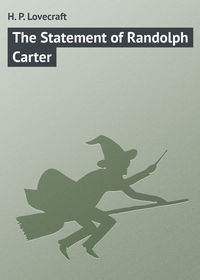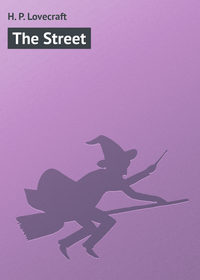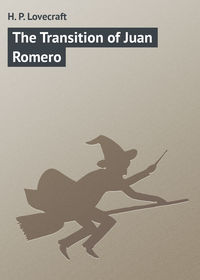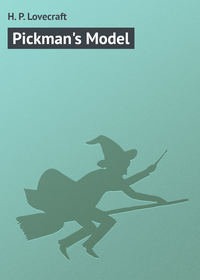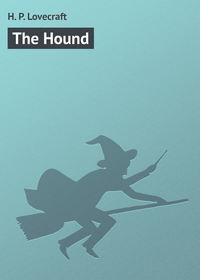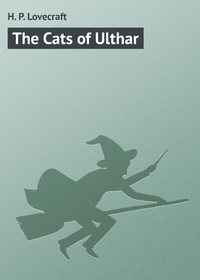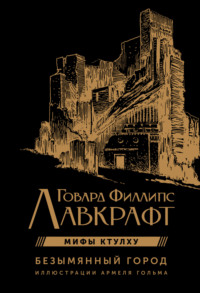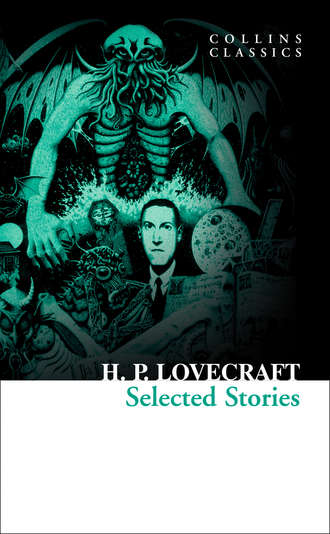
Полная версия
Selected Stories

SELECTED STORIES
H. P. Lovecraft

Copyright
William Collins
An imprint of HarperCollinsPublishers
1 London Bridge Street
London SE1 9GF
WilliamCollinsBooks.com
This William Collins eBook edition published in Great Britain in 2018
Life & Times section © HarperCollinsPublishers Ltd
Silvia Crompton asserts her moral rights as author of the Life & Times section
Classic Literature: Words and Phrases adapted from
Collins English Dictionary
Cover by e-Digital Design.
Cover image © Writer Howard Phillips (HP) Lovecraft (1890-1937) surrounded by monsters (top: Cthulhu), engraving, 1981 / Bridgeman Images.
A catalogue record for this book is available from the British Library
All rights reserved under International and Pan-American Copyright Conventions. By payment of the required fees, you have been granted the non-exclusive, non-transferable right to access and read the text of this e-book on-screen. No part of this text may be reproduced, transmitted, down-loaded, decompiled, reverse engineered, or stored in or introduced into any information storage and retrieval system, in any form or by any means, whether electronic or mechanical, now known or hereinafter invented, without the express written permission of HarperCollins
Source ISBN: 9780008284954
Ebook Edition © 2018 ISBN: 9780008284961
Version: 2018-01-18
Contents
Cover
Title Page
Copyright
History of William Collins
Life & Times
Dagon
The Statement of Randolph Carter
Herbert West–Reanimator
The Outsider
The Colour Out of Space
The Call of Cthulhu
The Silver Key
The Dunwich Horror
The Haunter of the Dark
The Thing on the Doorstep
Classic Literature: Words and Phrases
About the Publisher
History of William Collins
In 1819, millworker William Collins from Glasgow, Scotland, set up a company for printing and publishing pamphlets, sermons, hymn books, and prayer books. That company was Collins and was to mark the birth of HarperCollins Publishers as we know it today. The long tradition of Collins dictionary publishing can be traced back to the first dictionary William co-published in 1825, Greek and English Lexicon. Indeed, from 1840 onwards, he began to produce illustrated dictionaries and even obtained a licence to print and publish the Bible.
Soon after, William published the first Collins novel; however, it was the time of the Long Depression, where harvests were poor, prices were high, potato crops had failed, and violence was erupting in Europe. As a result, many factories across the country were forced to close down and William chose to retire in 1846, partly due to the hardships he was facing.
Aged 30, William’s son, William II, took over the business. A keen humanitarian with a warm heart and a generous spirit, William II was truly ‘Victorian’ in his outlook. He introduced new, up-to-date steam presses and published affordable editions of Shakespeare’s works and The Pilgrim’s Progress, making them available to the masses for the first time.
A new demand for educational books meant that success came with the publication of travel books, scientific books, encyclopedias, and dictionaries. This demand to be educated led to the later publication of atlases, and Collins also held the monopoly on scripture writing at the time.
In the 1860s Collins began to expand and diversify and the idea of ‘books for the millions’ was developed, although the phrase wasn’t coined until 1907. Affordable editions of classical literature were published, and in 1903 Collins introduced 10 titles in their Collins Handy Illustrated Pocket Novels. These proved so popular that a few years later this had increased to an output of 50 volumes, selling nearly half a million in their year of publication. In the same year, The Everyman’s Library was also instituted, with the idea of publishing an affordable library of the most important classical works, biographies, religious and philosophical treatments, plays, poems, travel, and adventure. This series eclipsed all competition at the time, and the introduction of paperback books in the 1950s helped to open that market and marked a high point in the industry.
HarperCollins is and has always been a champion of the classics, and the current Collins Classics series follows in this tradition – publishing classical literature that is affordable and available to all. Beautifully packaged, highly collectible, and intended to be reread and enjoyed at every opportunity.
Life & Times
‘The oldest and strongest emotion of mankind is fear, and the oldest and strongest kind of fear is fear of the unknown,’ wrote H. P. Lovecraft in a 1927 essay. ‘These facts few psychologists will dispute, and their admitted truth must establish for all time the genuineness and dignity of the weirdly horrible tale as a literary form.’
To modern readers it seems laughable that a writer of H. P. Lovecraft’s stature and popularity should feel it necessary to justify the value of his genre. Although he was one of the first to use the term ‘weird tale’, his name is nowadays synonymous with that mixture of horror, myth and fantasy . He introduced the world to Azathoth and Cthulhu, whose legacy has proven lucrative for successive generations of writers, artists and film-makers.
But not for Lovecraft himself. True success eluded him throughout his life, and by the time he died he was almost literally penniless.
Insatiable Curiosity
Howard Phillips Lovecraft was born in Providence, Rhode Island in 1890, into circumstances that appeared more promising than they really were. His mother’s family was well off; her father, Whipple Van Buren Phillips, was a noted businessman who was happy to pander to his grandson, an only child. But Lovecraft’s father suffered from mental illness and was confined to an institution when the boy was just three. It was the last they saw of each other.
The Phillips grandparents stepped in to help raise young Howard, encouraging him to read the classics from an early age – everything from Grimm’s Fairy Tales and Edgar Allan Poe to Ovid’s Metamorphoses – and indulging his ‘insatiable curiosity’ for chemistry by buying him books and apparatus for his little laboratory in the basement. ‘Being a “spoiled child” I had but to ask, and it was mine,’ he later recalled. By the age of nine, he was producing a magazine called The Scientific Gazette.
But Lovecraft was a sickly child, suffering general ill health and several nervous breakdowns through his youth. After the death of his grandmother when he was six, he ‘began to have nightmares of the most hideous description, peopled with things which [he] called “night-gaunts”’. When his grandfather died a few years later, he became ‘the most miserable of mortals’. As for friends and playmates: ‘I had none!’
The worst of his breakdowns occurred shortly before he was due to graduate from high school, as a result of which college was out of the question. Instead, isolated from his peers and the conventional trajectory into adult life, he spent what would have been his college years immersing himself in the science and literature of the eighteenth century, ‘of which I felt myself so oddly a part’.
Weird Tales
Lovecraft entered adulthood unqualified and insecure, but better read than anyone he knew. After some modest forays into journalism – letters to pulp-fiction magazines and a monthly astronomy column for the Providence Evening News – he was invited in 1914 to join the United Amateur Press Association. This validation set him on to a flurry of writing and submitting stories, poems and essays, and, although he remained reclusive and communicated mainly by letter, he started to hope that he might make his name as a writer of ‘weird tales’.
The Vagrant magazine was the first to showcase his work, publishing ‘The Alchemist’ (written in 1908) and ‘The Beast in the Cave’ (1905) in 1916 and 1918 respectively, followed soon after by ‘The Tomb’ and ‘The Statement of Randolph Carter’. In 1919 it printed ‘Dagon’, a story often credited as foreshadowing the Cthulhu stories for which Lovecraft remains best known. Like the later cycle of stories, ‘Dagon’ introduces a creature of such horrifying size and power that it exposes humankind as both naive and insignificant.
All the while, Lovecraft continued to read voraciously, discovering great horror writers such as M. R. James and Guy de Maupassant, as well as the fantasy writer Lord Dunsany, who he later said influenced him more than anyone except his ‘God of Fiction’, Edgar Allan Poe. In 1922, he plucked up the courage to write to a new literary hero of his, Clark Ashton Smith, sparking a correspondence that would continue for the rest of his life.
By the time the magazine Weird Tales was launched in 1923, Lovecraft was well enough known to be of interest to its editors. Between 1924 and 1926, in a successful attempt to boost circulation, they commissioned him to ghost-write (albeit without credit) a series of stories conceived by Harry Houdini.
Success and Rejection
In 1921, shortly after the death of his mother, Lovecraft met writer and businesswoman Sonia H. Greene at a National Amateur Press Association convention. They married in 1924 and moved to New York City, where they were surrounded by other writers on the pulp-fiction scene (Lovecraft was soon accepted into the Kalem Club, a group of like-minded authors whose surnames all began with K, L or M).
As his cultish fame grew through his popularity with the editors and readers of Weird Tales, particularly after the magazine published the hugely influential ‘The Call of Cthulhu’ in 1928, his circle of literary acquaintances became more intensely focused around him personally. The so-called Lovecraft Circle, which included Clark Ashton Smith, Robert E. Howard and August Derleth, was in no doubt about Lovecraft’s brilliance, finding in ‘The Call of Cthulhu’ the seeds of what they called a ‘Cthulhu Mythos’, a fully formed universe with its own pantheon of ancient deities, in which Derleth and others soon began setting their own stories.
Lovecraft himself remained intensely insecure about his own work, however (he’d originally considered ‘The Call of Cthulhu’ ‘rather middling’), and was swallowed by waves of despondency whenever Weird Tales declined to publish a story. When his novella At the Mountains of Madness was rejected for being too long, he despaired that he had ‘failed to crystallise the mood I was trying to crystallise’. Convinced that he was becoming ‘a parody on the only thing in life that means anything to me’, he didn’t even submit 1933’s ‘The Thing on the Doorstep’ to the magazine, and it only appeared there after his death.
I Am Providence
Lovecraft’s marriage to Sonia H. Greene was not a success. He was eternally on the verge of destitution and she suffered from bouts of ill health, and within two years they were living apart. In many ways he felt New York was to blame, and that he had made a terrible mistake in moving there at all. Writing to his aunt Lillian in 1926, he exclaimed, ‘It is New England I must have – in some form or other. Providence is part of me – I am Providence … Providence is my home, & there I shall end my days.’
With the marriage over, Lovecraft did just that: he moved back to Providence and continued writing stories, surviving on an inheritance until it ran out. By the time he was diagnosed with cancer in 1937, he was subsisting on almost nothing, and he died that year aged forty-six.
In his heart of hearts Lovecraft had always longed to secure a book deal, and felt that ‘incidental magazine placements’ compromised a serious writer’s ‘intellectual & aesthetic integrity’. It was only in the wake of his death that his true contribution to the weird-fiction canon – and to the many writers who continued in his footsteps – became apparent. Weird Tales had an enormous cache of unpublished stories and was able to print ‘new’ Lovecraft work for years after he died. By the 1960s he had garnered a new cult following of readers who valued him as an outsider, a rebel and an artist who challenged the world order.
‘The true function of phantasy is to give the imagination a ground for limitless expansion,’ Lovecraft had written to Clark Ashton Smith in 1930, ‘and to satisfy aesthetically the sincere and burning curiosity and sense of awe which a sensitive minority of mankind feel toward the alluring and provocative abysses of unplumbed space and unguessed entity.’
DAGON
I am writing this under an appreciable mental strain, since by tonight I shall be no more. Penniless, and at the end of my supply of the drug which alone makes life endurable, I can bear the torture no longer; and shall cast myself from this garret window into the squalid street below. Do not think from my slavery to morphine that I am a weakling or a degenerate. When you have read these hastily scrawled pages you may guess, though never fully realize, why it is that I must have forgetfulness or death.
It was in one of the most open and least frequented parts of the broad Pacific that the packet of which I was supercargo fell a victim to the German sea-raider. The great war was then at its very beginning, and the ocean forces of the Hun had not completely sunk to their later degradation; so that our vessel was made a legitimate prize, whilst we of her crew were treated with all the fairness and consideration due us as naval prisoners. So liberal, indeed, was the discipline of our captors, that five days after we were taken I managed to escape alone in a small boat with water and provisions for a good length of time.
When I finally found myself adrift and free, I had but little idea of my surroundings. Never a competent navigator, I could only guess vaguely by the sun and stars that I was somewhat south of the equator. Of the longitude I knew nothing, and no island or coastline was in sight. The weather kept fair, and for uncounted days I drifted aimlessly beneath the scorching sun; waiting either for some passing ship, or to be cast on the shores of some habitable land. But neither ship nor land appeared, and I began to despair in my solitude upon the heaving vastness of unbroken blue.
The change happened whilst I slept. Its details I shall never know; for my slumber, though troubled and dream-infested, was continuous. When at last I awaked, it was to discover myself half sucked into a slimy expanse of hellish black mire which extended about me in monotonous undulations as far as I could see, and in which my boat lay grounded some distance away.
Though one might well imagine that my first sensation would be of wonder at so prodigious and unexpected a transformation of scenery, I was in reality more horrified than astonished; for there was in the air and in the rotting soil a sinister quality which chilled me to the very core. The region was putrid with the carcasses of decaying fish, and of other less describable things which I saw protruding from the nasty mud of the unending plain. Perhaps I should not hope to convey in mere words the unutterable hideousness that can dwell in absolute silence and barren immensity. There was nothing within hearing, and nothing in sight save a vast reach of black slime; yet the very completeness of the stillness and the homogeneity of the landscape oppressed me with a nauseating fear.
The sun was blazing down from a sky which seemed to me almost black in its cloudless cruelty; as though reflecting the inky marsh beneath my feet. As I crawled into the stranded boat I realized that only one theory could explain my position. Through some unprecedented volcanic upheaval, a portion of the ocean floor must have been thrown to the surface, exposing regions which for innumerable millions of years had lain hidden under unfathomable watery depths. So great was the extent of the new land which had risen beneath me, that I could not detect the faintest noise of the surging ocean, strain my ears as I might. Nor were there any sea-fowl to prey upon the dead things.
For several hours I sat thinking or brooding in the boat, which lay upon its side and afforded a slight shade as the sun moved across the heavens. As the day progressed, the ground lost some of its stickiness, and seemed likely to dry sufficiently for travelling purposes in a short time. That night I slept but little, and the next day I made for myself a pack containing food and water, preparatory to an overland journey in search of the vanished sea and possible rescue.
On the third morning I found the soil dry enough to walk upon with ease. The odour of the fish was maddening; but I was too much concerned with graver things to mind so slight an evil, and set out boldly for an unknown goal. All day I forged steadily westward, guided by a far-away hummock which rose higher than any other elevation on the rolling desert. That night I encamped, and on the following day still travelled towards the hummock, though that object seemed scarcely nearer than when I had first espied it. By the fourth evening I attained the base of the mound, which turned out to be much higher than it had appeared from a distance; an intervening valley setting it out in sharper relief from the general surface. Too weary to ascend, I slept in the shadow of the hill.
I know not why my dreams were so wild that night; but ere the waning and fantastically gibbous moon had risen far above the eastern plain, I was awake in a cold perspiration, determined to sleep no more. Such visions as I had experienced were too much for me to endure again. And in the glow of the moon I saw how unwise I had been to travel by day. Without the glare of the parching sun, my journey would have cost me less energy; indeed, I now felt quite able to perform the ascent which had deterred me at sunset. Picking up my pack, I started for the crest of the eminence.
I have said that the unbroken monotony of the rolling plain was a source of vague horror to me; but I think my horror was greater when I gained the summit of the mound and looked down the other side into an immeasurable pit or canyon, whose black recesses the moon had not yet soared high enough to illumine. I felt myself on the edge of the world; peering over the rim into a fathomless chaos of eternal night. Through my terror ran curious reminiscences of Paradise Lost, and Satan’s hideous climb through the unfashioned realms of darkness.
As the moon climbed higher in the sky, I began to see that the slopes of the valley were not quite so perpendicular as I had imagined. Ledges and outcroppings of rock afforded fairly easy footholds for a descent, whilst after a drop of a few hundred feet, the declivity became very gradual. Urged on by an impulse which I cannot definitely analyse, I scrambled with difficulty down the rocks and stood on the gentler slope beneath, gazing into the Stygian deeps where no light had yet penetrated.
All at once my attention was captured by a vast and singular object on the opposite slope, which rose steeply about a hundred yards ahead of me; an object that gleamed whitely in the newly bestowed rays of the ascending moon. That it was merely a gigantic piece of stone, I soon assured myself; but I was conscious of a distinct impression that its contour and position were not altogether the work of Nature. A closer scrutiny filled me with sensations I cannot express; for despite its enormous magnitude, and its position in an abyss which had yawned at the bottom of the sea since the world was young, I perceived beyond a doubt that the strange object was a well-shaped monolith whose massive bulk had known the workmanship and perhaps the worship of living and thinking creatures.
Dazed and frightened, yet not without a certain thrill of the scientist’s or archaeologist’s delight, I examined my surroundings more closely. The moon, now near the zenith, shone weirdly and vividly above the towering steeps that hemmed in the chasm, and revealed the fact that a far-flung body of water flowed at the bottom, winding out of sight in both directions, and almost lapping my feet as I stood on the slope. Across the chasm, the wavelets washed the base of the Cyclopean monolith, on whose surface I could now trace both inscriptions and crude sculptures. The writing was in a system of hieroglyphics unknown to me, and unlike anything I had ever seen in books, consisting for the most part of conventionalized aquatic symbols such as fishes, eels, octopi, crustaceans, molluscs, whales and the like. Several characters obviously represented marine things which are unknown to the modern world, but whose decomposing forms I had observed on the ocean-risen plain.
It was the pictorial carving, however, that did most to hold me spellbound. Plainly visible across the intervening water on account of their enormous size was an array of bas-reliefs whose subjects would have excited the envy of a Doré. I think that these things were supposed to depict men – at least, a certain sort of men; though the creatures were shown disporting like fishes in the waters of some marine grotto, or paying homage at some monolithic shrine which appeared to be under the waves as well. Of their faces and forms I dare not speak in detail; for the mere remembrance makes me grow faint. Grotesque beyond the imagination of a Poe or a Bulwer, they were damnably human in general outline despite webbed hands and feet, shockingly wide and flabby lips, glassy, bulging eyes, and other features less pleasant to recall. Curiously enough, they seemed to have been chiselled badly out of proportion with their scenic background; for one of the creatures was shown in the act of killing a whale represented as but little larger than himself. I remarked, as I say, their grotesqueness and strange size; but in a moment decided that they were merely the imaginary gods of some primitive fishing or seafaring tribe; some tribe whose last descendant had perished eras before the first ancestor of the Piltdown or Neanderthal Man was born. Awestruck at this unexpected glimpse into a past beyond the conception of the most daring anthropologist, I stood musing whilst the moon cast queer reflections on the silent channel before me.
Then suddenly I saw it. With only a slight churning to mark its rise to the surface, the thing slid into view above the dark waters. Vast, Polyphemus-like, and loathsome, it darted like a stupendous monster of nightmares to the monolith, about which it flung its gigantic scaly arms, the while it bowed its hideous head and gave vent to certain measured sounds. I think I went mad then.
Of my frantic ascent of the slope and cliff, and of my delirious journey back to the stranded boat, I remember little. I believe I sang a great deal, and laughed oddly when I was unable to sing. I have indistinct recollections of a great storm some time after I reached the boat; at any rate, I know that I heard peals of thunder and other tones which Nature utters only in her wildest moods.
When I came out of the shadows I was in a San Francisco hospital; brought thither by the captain of the American ship which had picked up my boat in mid-ocean. In my delirium I had said much, but found that my words had been given scant attention. Of any land upheaval in the Pacific, my rescuers knew nothing; nor did I deem it necessary to insist upon a thing which I knew they could not believe. Once I sought out a celebrated ethnologist and amused him with peculiar questions regarding the ancient Philistine legend of Dagon, the Fish-God; but soon perceiving that he was hopelessly conventional, I did not press my inquiries.




